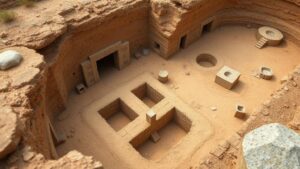Searching for ruins of coastal cities in the Sea of Marmara, lost to earthquakes and tsunamis.
Searching for Ruins of Coastal Cities in the Sea of Marmara
The Sea of Marmara, an inland sea connecting the Aegean and Black Seas, has witnessed centuries of tectonic upheaval, resulting in the loss of coastal cities to earthquakes and tsunamis. This region, rich in history, is dotted with submerged ruins that tell stories of ancient civilizations. Researchers and archaeologists have been increasingly focused on uncovering these underwater remnants to gain insights into their historical significance and the geological events that led to their downfall.
Historical Context
The Sea of Marmara has long been a focal point for various civilizations, including the Byzantines and Ottomans. With cities such as Byzantium (modern-day Istanbul) thriving on its shores, the area has seen both prosperity and devastation. The most notable geological event that affected the coastal cities was the 1912 Ganos earthquake, which reached a magnitude of 7.4. This seismic activity caused significant destruction along the coast and is believed to have shifted landscapes dramatically.
Key Geological Events
Throughout history, the Sea of Marmara has been subjected to numerous earthquakes and tsunamis. Some notable events include:
- 1719 Ottoman Earthquake: This earthquake was recorded to have caused widespread damage to İstanbul and surrounding settlements.
- 1999 İzmit Earthquake: With a magnitude of 7.4, this earthquake resulted in substantial loss of life and infrastructure in the region, causing new underwater landforms.
- 590 AD Tsunami: An event during the Byzantine era that submerged parts of the coastal cities, altering their geography forever.
Underwater Archaeology
Underwater archaeology has become an essential tool in exploring these submerged ruins. Through advanced technologies like remote-operated vehicles (ROVs) and sonar scanning, researchers can map the seafloor and identify structures that lie beneath the waves. In 2015, a team from Istanbul Technical University discovered remnants of a submerged Byzantine settlement near the island of Princes Islands, showcasing the potential for further exploration.
Challenges and Environmental Considerations
While the search for these ruins is promising, several challenges exist:
- Environmental Conditions: The Sea of Marmaras murky waters and strong currents can hinder visibility and access to sites.
- Legal and Preservation Issues: Ensuring that archaeological efforts do not infringe upon local fisheries and marine ecosystems is paramount.
Also, climate change poses threats to many coastal areas, with rising sea levels further complicating preservation efforts. Engaging with local communities is crucial for ensuring that exploration efforts respect both historical significance and contemporary livelihoods.
Future Directions in Research
Advancements in technology continue to improve our ability to study underwater sites. Multibeam sonar and underwater drones allow for extensive mapping of submerged landscapes, enabling researchers to create detailed 3D models of sunken cities. Collaborations between universities, local governments, and international archaeological bodies facilitate interdisciplinary studies that can yield significant insights.
Real-World Applications
The study of ruins in the Sea of Marmara can have diverse applications:
- Cultural Preservation: Understanding these histories helps safeguard cultural heritage and informs conservation practices.
- Disaster Preparedness: Insights into past geological events can enhance current seismic hazard assessments and urban planning efforts.
As researchers continue to explore these underwater realms, future findings may reshape our understanding of regional history and contribute to a greater comprehension of earthquake dynamics.
Conclusion
The search for the ruins of coastal cities submerged in the Sea of Marmara not only reveals lost histories but also underscores the power of nature in shaping human civilization. As technology advances, the potential for uncovering more about these ancient settlements becomes increasingly possible. Engaging in careful, respectful exploration will ensure that both the stories these ruins hold and the marine environments they inhabit are preserved for future generations.


